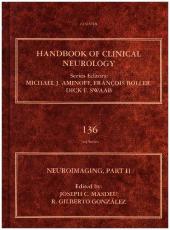 Neuerscheinungen 2016Stand: 2020-02-01 |
Schnellsuche
ISBN/Stichwort/Autor
|
Herderstraße 10
10625 Berlin
Tel.: 030 315 714 16
Fax 030 315 714 14
info@buchspektrum.de |

R. Gilberto Gonzalez, Joseph C. Masdeu
(Beteiligte)
Neuroimaging
Herausgegeben von Masdeu, Joseph C.; Gonzalez, R. Gilberto
2016. 720 S. 264 mm
Verlag/Jahr: ELSEVIER 2016
ISBN: 0-444-53486-5 (0444534865)
Neue ISBN: 978-0-444-53486-6 (9780444534866)
Preis und Lieferzeit: Bitte klicken
Neuroimaging, Part Two, a volume in The Handbook of Clinical Neurology series, illustrates how neuroimaging is rapidly expanding its reach and applications in clinical neurology. It is an ideal resource for anyone interested in the study of the nervous system, and is useful to both beginners in various related fields and to specialists who want to update or refresh their knowledge base on neuroimaging.
This second volume covers imaging of the adult spine and peripheral nervous system, as well as pediatric neuroimaging. In addition, it provides an overview of the differential diagnosis of the most common imaging findings, such as ring enhancement on MRI, and a review of the indications for imaging in the most frequent neurological syndromes.
The volume concludes with a review of neuroimaging in experimental animals and how it relates to neuropathology. It brings broad coverage of the topic using many color images to illustrate key points. Contributions from leading global experts are collated, providing the broadest view of neuroimaging as it currently stands.
For a number of neurological disorders, imaging is not only critical for diagnosis, but also for monitoring the effect of therapies, with the entire field moving from curing diseases to preventing them. Most of the information contained in this volume reflects the newness of this approach, pointing to the new horizon in the study of neurological disorders.
Provides a relevant description of the technologies used in neuroimaging, such as computed tomography, magnetic resonance imaging, positron emission tomography, and several others
Discusses the application of these techniques to the study of brain and spinal cord disease
Explores the indications for the use of these techniques in various syndromes
Section III Spinal Diseases 32. Functional anatomy of the spine 33. Neuroimaging of spine tumors 34. Vascular disease of the spine 35. Infection 36. Non-infectious inflammatory disorders 37. Imaging of trauma of the spine 38. Metabolic and hereditary myelopathies 39. Degenerative spine disease Section IV Diseases of the Peripheral Nervous System 40. Peripheral Nerves 41. Muscle: MRI 42. Muscle: Ultrasound Section V Neurological Syndromes of the Adult: When and How to Image 43 Sudden Neurological Deficit 44.Pituitary imaging 45. Visual Impairment 46. Vertigo and Hearing Loss 47. Progressive Weakness or Numbness of Central or Peripheral Origin 48. Gait and balance disorders 49. Movement Disorders 50. Cognitive or Behavioral Impairment 51. Epilepsy 52. Myelopathy 53. Low Back Pain, Radiculopathy Section VI Differential Diagnosis of Imaging Findings 54. Structural Imaging of the Brain: MRI, CT 55. Vascular Imaging: ultrasound 56. Diffusion tensor imaging and functional MRI Section VII Pediatric Neuroimaging 57. Normal development 58. Congenital anomalies of the brain and spine 59. Tumors 60. Vascular disease 61. Infections 62. Trauma 63. Metabolic, endocrine and other genetic disorders 64. Cerebrospinal fluid circulation disorders 65. Indications for the performance of neuroimaging in children Section VIII Interventional Neuroimaging 66. Endovascular Treatment of Acute Ischemic Stroke 67. Endovascular treatment of Intracranial Aneurysms 68. Endovascular treatment of vascular malformations Section IX Neuropathology and Experimental Models 69. Postmortem imaging and neuropathologic correlations with imaging


